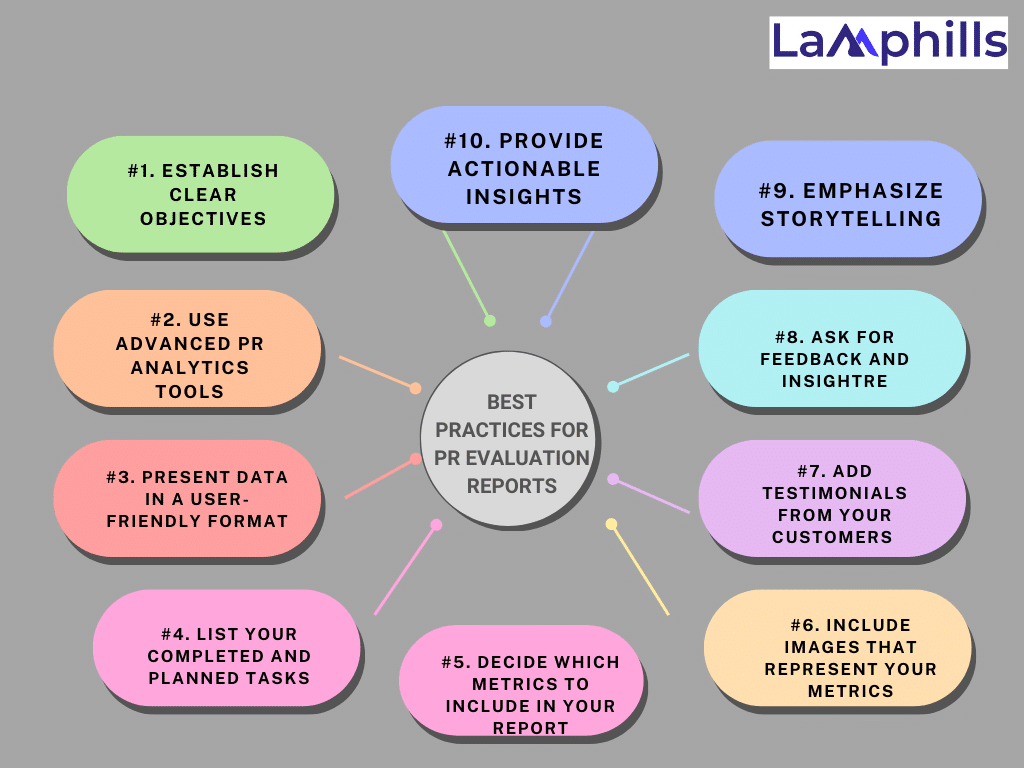If you’ve ever worked on a public relations campaign, you know that the joy of launching a fresh venture is frequently equaled by the uncertainty of determining its effectiveness. When I initially started in public relations, I assumed that success was all about creating awareness. Then we’d love to see our press releases taken up, our social media profiles grow in followers, and our brand name appear in notifications from Google. It felt wonderful to be a part of something that appeared to be gathering momentum.
But then the higher-ups started asking questions. “How can we know if all of this talk is beneficial to the business? What is the return on all this effort? Is there a method to see if we’re reaching the right people? That’s when I realized there’s a lot more to PR success than just getting noticed. I had to move beyond the surface and start digging into the data.
As a result, in this article, I’ll discuss what I’ve learned about writing the best PR evaluation reports. By looking at key metrics and best practices for using public relations reports to drive business results. In the end, you’ll have an excellent understanding of how to measure and convey the impact of your public relations activities, so when your CEO asks for results, you’ll be prepared. Let us get started.
Key Takeaways
- PR success is not just about generating awareness and media coverage but also about understanding the impact of PR efforts on business outcomes. Effective PR evaluation involves gathering data to determine how well the organization has met its objectives and aligning PR activities with business goals.
- Key Metrics for PR evaluation include media coverage quality, audience reach, engagement quality, sentiment analysis, and return on investment (ROI).
- To create effective PR evaluation reports, start by establishing clear objectives, using advanced PR analytics tools, presenting data in a user-friendly format, and emphasizing storytelling. These practices help communicate the impact of PR activities in a way that is understandable and engaging for stakeholders.
- PR evaluation offers several benefits, including increased credibility, share of voice, brand influence, and the ability to hear public perception.
What is PR evaluation?

PR evaluation means gathering data to determine how effectively the organization has met its objectives and aims. Hence, surveys, media content analysis, and online metrics are all used to assess the performance of a public relations campaign. Surveys collect feedback from target audiences and stakeholders, media content analysis evaluates the amount and quality of coverage generated, and online metrics track activity on digital platforms.
This is why businesses use it to analyze the success of their messaging, campaign reach, and overall impact on brand perception. They obtain vital insights about their target audience, which helps them optimize plans and match them with company objectives. The evaluation also tracks progress over time and rates performance based on reach, engagement, and public impression. more brand awareness – helping identify areas for improvement.
In other words, evaluating a public relations campaign is critical for businesses to measure progress toward goals, understand how messages are received, assess effectiveness, track progress over time, gain insights into the target audience, and improve strategies for better-aligning media impressions with business objectives.
Understanding What is PR Reporting Is
To get started, If you work in public relations, at some point you are going to be asked to account for the work you do in your public relations efforts.
PR reporting is the documenting of a PR professional’s work and progress. This reporting monitors a public relations professional’s goals, implementation techniques, activities performed, and metrics used to assess the progress of their efforts. That is, it gives a firm, its customers, and investors an overview of the brand’s current position and future aspirations. PR professionals employ several reporting methodologies depending on the project, goals, and meeting intervals. There are various types of public relations reporting, including:
- Monthly reports: These reports include basic information about one’s progress over the past 30 days. You usually provide these to your direct supervisor.
- Quarterly reports: These typically appeal to higher-level managers, such as senior PR professionals and executives. They outline your progress over approximately 90 days and help you demonstrate the results of your work, defending your PR budget in the process.
- Annual reports: This type of report is the most important. They describe to a CEO, major investors, and others with authority over your project whether you have a suitable project budget and whether a project is worth continuing.
- Campaign reports: PR professionals prepare campaign reports to outline their goals before starting a campaign and explain how they plan to monitor it throughout each stage. They can then use monthly, quarterly, and annual reports to follow up on a campaign’s progress.
- Crisis reports: These allow PR managers to relay information about a crisis and explain the steps they took to resolve an issue and improve the brand’s perception.
Key Metrics for Get PR Evaluation Reports
Let’s dive into the key metrics that can help you bridge that gap and create meaningful PR evaluation reports.
#1. Media Coverage

Media coverage is a natural starting point. However, it is more than just numbers; it is about quality. I previously worked on a campaign that received a lot of attention, but when we looked closer, the majority of the coverage came from low-traffic websites or niche blogs. It was not the kind of exposure that would impress our investors. Instead, concentrate on acquiring attention in credible publications that are consistent with your brand’s image. Cision’s 2023 study states that “85% of journalists consider the publication’s reputation when deciding which stories to cover.”
#2. Audience Reach

The audience reach metric reflects how many people are exposed to your public relations effort. I remember an event where we had significant coverage in a national publication. The audience reach was great, yet it did not result in significant engagement or ROI. That’s when I learned that reach is only one part of the effort. To determine the impact of your PR activities, you must delve deeper into the data.
#3. Engagement
Engagement is when things begin to get interesting. Hence, it is not only important to know how many people saw your material, but also how they interacted with it. I worked on an extremely popular social media campaign. However, when we analyzed the engagement metrics—likes, shares, comments—we realized that most of the interaction was superficial. It taught me that engagement is about quality, not just quantity.
#4. Sentiment Analysis
Sentiment analysis is similar to reading between the lines of your media coverage. It’s not just about counting mentions; it’s also about determining if they’re favorable, negative, or neutral.
#5. Return on Investment (ROI)
ROI is the ultimate metric for any business activity, and PR is no exception. This is because it measures whether your PR efforts are generating more value than they cost. I remember a campaign where we were able to track sales back to a specific PR initiative.
#6. Website Traffic
The goal of any public relations campaign is to generate interest in your product or service, either directly or indirectly. As a result, it’s usually a good idea to measure your web traffic before the PR campaign and then compare it afterward.
The piece may be triggering calls to action (CTAs), such as looking at a specific product, trying a sample, or creating an inquiry, all of which can be tracked in real-time using the website’s analytics, such as Google Analytics. You might even notice discrepancies in your outcomes compared to what you expect.
But trust me, all of this information will provide useful insight into your customer’s behavior, not just for PR but also for influencing the effect of your campaigns, or even highlighting website usability issues (link to website usability page).
#7. Email Responses, YouTube Channels, Social Media Channels

PR can also be promoted through your email database, YouTube if you use it, and social media channels. Not obvious to some as PR, but it’s still an earned media; you have worked to establish that database and this is an opportunity to use it. There are many ways you can monitor the effectiveness of this, such as:
- Click-through rates (CTRs) – the number of people who for example click through to your website.
- Conversion rate – the number of people who click through and complete actions (i.e. clicking a phone number, purchasing, or completing a form).
- Media sharing or forwarding rates – a percentage of people who clicked on share or forwarded on.
- Engagements – this is mentions, comments, and reactions to social shares.
#8. Lead Sourcing
A well-crafted public relations strategy, as discussed under website traffic, should have a direct impact on your target audience’s sales or engagement. This is where the calls to action (CTAs) come into play. Any PR should generate leads, and working closely with your sales staff is essential to ensuring that PR serves this function as well as general brand awareness. As well as build a baseline of leads before and after the PR release, as well as techniques to track if the PR was a contributing factor to any increase in sales inquiries.
#9. Market Surveys

Before you begin developing your public relations or marketing strategy, you should conduct research. This can be accomplished by doing market research using surveys, questionnaires, or interviews, either online or in person. This is because these actions can assist you in determining where you are presently in terms of brand recognition or possible customer intent to purchase the service or product, for example. This will also establish a benchmark, and you can repeat the research after the PR campaign to see whether there is a significant difference. You can also include questions to determine whether the PR effort was seen or noticed.
Best Practices for PR Evaluation Reports

Now that we’ve covered the key metrics, let’s talk about some best practices for creating effective PR evaluation reports.
#1. Establish Clear Objectives
Before you begin a public relations strategy, have a clear goal in mind. This is because establishing clear objectives from the start allows you to match your public relations activities with the business’s goals and select the appropriate KPIs to track.
#2. Use Advanced PR Analytics Tools
Before preparing a PR report, consider the kind of PR tools that will allow you to efficiently offer project updates. Many public relations professionals choose to use software that produces visually appealing outcomes and speeds the formatting process. Others believe that simple word-processing documents are sufficient for communicating their findings.
Even better, technology has made PR evaluation significantly easier. Tools like Meltwater and Cision can help you track media mentions, gauge sentiment, and even compute ROI. When I first used these tools, it was as if a lightbulb went off—I could see the entire picture at once it saved me a lot of time and offered more precise information.
#3. Present Data in a User-Friendly Format
PR evaluation reports can get complex, so it’s essential to present data in a way that’s easy to understand. I always include charts and graphs to illustrate key points, and I use plain language to explain the data. A colleague once told me that a good PR report should be understandable even to someone outside the industry. I think that’s solid advice.
#4. List Your Completed and Planned Tasks
Consider starting your report by listing the tasks you’ve completed within the past month, quarter, or year, depending on the type of report you’re writing. It’s also important to include bullet points for readability and add dates and numbers when possible to make the document more organized and readable. For example, you might note in an event planning project that you recruited three new sponsors for $1 million each.
#5. Decide which Metrics to Include in Your Report
Metrics, also known as key performance indicators (KPIs), show you and your stakeholders how much interaction your target market has with your brand or project over a specific period. Metrics typically refer to online behaviors, as PR professionals perform nearly all initiatives digitally and track them using specialized marketing software.
#6. Include Images That Represent Your Metrics
The capacity to translate data into visual aids, such as charts and graphs, that help stakeholders realize the effect of your data is common in software used to prepare PR reports. It also eliminates the challenge of reading through large amounts of material, which can assist keep your audience’s interest. If you prefer to compose your own public relations reports in a word processor, you can use built-in graphics creation and inclusion capabilities.
#7. Add Testimonials From Your Customers
If you currently provide your product or service to a test group or the company has placed it on the market, consider including testimonials along with your metrics. This is because testimonials provide actual feedback about how people perceive your brand and what you offer. They can also show stakeholders the positive impact of your project and encourage their continued support of your efforts.
#8. Emphasize Storytelling
PR is all about storytelling, so, all your evaluation reports should reflect that. I like to include real-world examples, case studies, and success stories to bring the data to life. This approach not only makes the report more engaging but also helps build trust with stakeholders. It’s not just numbers; it’s a story that shows the impact of your work.
#9. Ask for Feedback and Insight
Near the end of a PR report, PR professionals include a section with questions for managers, team members, and investors. This section usually asks for input about a project, opinions on next steps, and assistance with certain aspects. Motivating those involved to offer their feedback and collaborate on the initiative can help increase enthusiasm and improve progress toward shared goals.
#10. Provide Actionable Insights
PR evaluation reports should offer more than just a review of past performance. It should also provide actionable insights for the future. I always include a section with specific recommendations for improving our PR strategies. This proactive approach shows that you’re not just evaluating—you’re actively working to make things better.
Example Of A PR Evaluation Report
Here’s an example of my PR report sometimes ago to help you craft your own:
What benefits will my business see from PR evaluation?
You can learn about the benefits but you must grasp the strength and impact of these benefits on your business. Everything, from brand awareness to lead generation, should have a long-term influence on your bottom line; otherwise, why bother? However, in marketing, it can be difficult to track how various touch points (advertising, public relations, social media, and so on) affect final sales and business performance. That is where the evaluation comes in. Understanding these sometimes less tangible implications, evaluation might aid you:
#1. Increases in Credibility
Due to the nature of PR being earned, it is often regarded as more “credible” by readers/viewers. Think about your own experiences of watching the news or flicking through your social media streams. As much as there are issues with fake news, people still believe more, what is said about a product or service if it is not from the brand directly (even if that’s perception rather than the reality). S. H Simmons – a US Author and Public speaker once said:
“If the young man tells his date she’s intelligent, looks lovely, and is a great conversationalist, he’s saying the right things to the right person and that’s marketing. If someone else tells the young woman how handsome, smart, and successful her date is – that’s PR.”
And I think that helps illustrate the power of someone else’s recommendation.
#2. Increased Share of Voice/Authority of Voice
This refers to your impact in the sector/marketplace compared to other brands, this can also reflect on the authority of the voice of your brand which can be very influential for audiences. With PR you are reinforcing any paid activities with external verifications of your messaging. This increases the acceptance of the message by the audience.
#3. Increased Brand Influence and Recall
You can obtain accurate statistics, reports, and feedback on the impact of your PR by using evaluation methods such as looking at mentions. PR, like share of voice, complements and reinforces sponsored PR messages while also providing access to broader external networks to expand your market reach. This increases the exposure of your brand and messaging to people outside of your network, as well as the chances that your brand will be viewed. According to Microsoft, it takes 6-20 times for a brand to be recalled (link to Microsoft Research), and public relations can help enhance the prospects.
#4. Enables You to Hear What People Think About You
Using PR can often enable you to monitor how people receive your messages and openly react to them. As the media is earned and therefore free, the interpretation of the content is down to the reviewer and the viewer. So evaluating PR can help you assess if the perception of your brand/product/service/message is positive or negative.
#5. Create Research Insights
Due to the perception and open review of your business that PR can offer, it can often help identify repeating patterns or trends in the comments, which could lead to improvements or new products or services, you may not have thought about before. So for example, if you released a new phone, that received positive feedback, but a reoccurring comment in the mentions was; “It is great, but I wish it had a better camera/it was smaller/the battery lasted longer.” These are insights you would normally have to pay for with official market research, but here they are free!
Who sees the PR report?
Anyone who is invested in your public relations activities should have access to regular updates on what is going on. Clients who pay you for your services may receive the PR report, as may the CEO or CFO of a firm for which you work, stakeholders who have an investment in the company, department heads, or those in charge of finance and accounting.
How often should public relations reports be drafted?
This will vary. It could be monthly, quarterly, annual, post-campaign, or none of the above. Some clients prefer frequent reporting, while others have no time or interest in micromanaging your public relations activities. If the reporting is too infrequent, it is difficult to correct course. If reporting is happening too frequently, it can be hard to see trends over time.
Is a PR report different from a clipping report?
It may seem confusing, but PR reports and clipping reports are not the same thing. A clipping report is a collection of brand mentions and coverage that is used to track PR coverage and assess campaign effectiveness. It can be distributed to managers or team members as needed. It is not the same as a full PR report, but it is still a valuable tool. Many people will use a service (such as a media monitoring service, Google Alerts, or both) to aid in their clipping efforts.
What are the five levels of evaluation of any PR plan?
When reviewing a public relations plan, it is critical to include all five evaluation levels: output, outreach, outcome, outgrowth, and outperform. Each stage provides information about the success of public relations actions and initiatives, allowing organizations to guarantee they are fulfilling campaign goals.
Conclusion
Creating PR evaluation reports might seem like a daunting task, but once you understand the key metrics and best practices, it becomes a valuable tool for guiding your PR strategy. By focusing on media coverage, audience reach, engagement, sentiment analysis, and ROI, you’ll have a comprehensive view of how your PR campaigns are performing.
So, the next time you’re wondering whether your PR efforts are making a difference, remember that a well-crafted PR evaluation report can provide the answers you’re looking for. It’s not just about numbers; it’s about understanding and improving the impact of your PR efforts. And that’s a story worth telling.
References
- brand24.com
- ntkmarketing.co.uk
- indeed.com
- prezly.com






